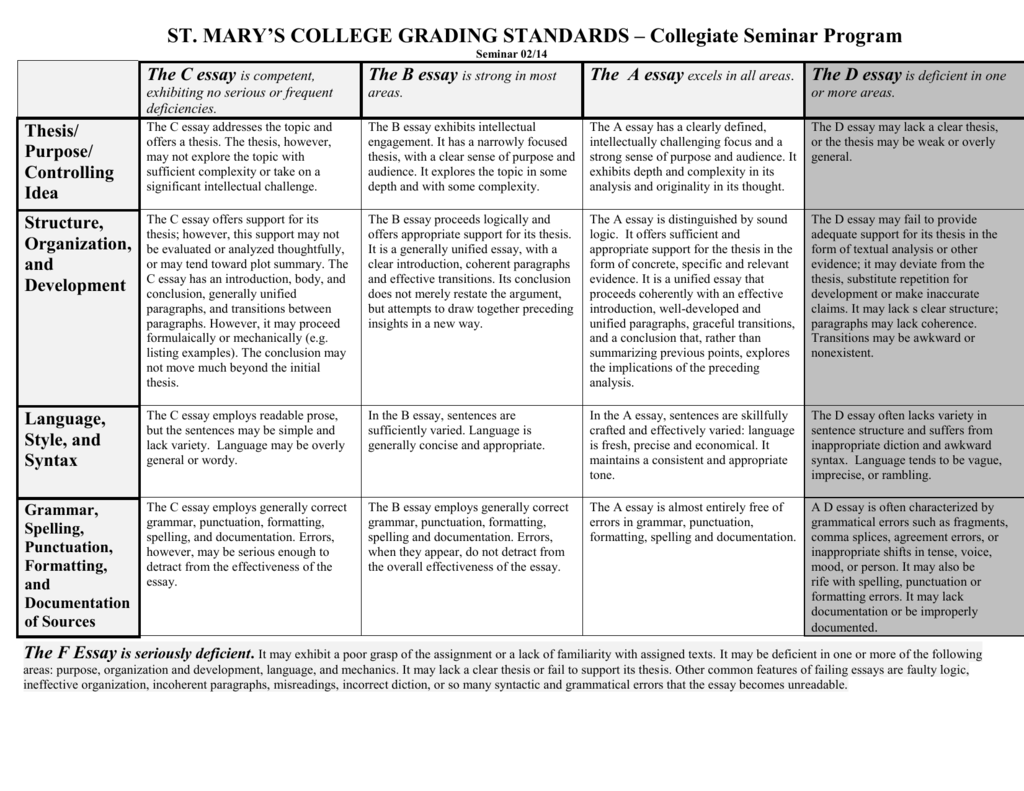
The B essay is characterized by the following: 1. a clearly defined thesis; 2. strong support of the thesis but with the need of some explanation or additional development; 3. usually logical and effective organization of the full essay; 4. clear structure of paragraphs; 5. logical transitions between sentences and paragraphs; 6 Making Standards of Evaluation Clear to Students Grading Rubrics. Sometimes, instructors wish to make their standards more explicit to students. A systematic Modeling Your Grading. A simple, effective method to demonstrate your standards is to grade a paper in front of the Providing Benchmark Guidelines for Grading An Essay. This exercise intends to take the mystery out of grading papers. It is true that many teachers and professors have their own “style” of grading. But all follow some general rules of thumb when they grade your papers. A Good Essay. Every essay must contain three essential elements
Grading Essays | GSI Teaching & Resource Center
Grade for Learning Objectives Response to Writing Errors Commenting on Student Papers Plagiarism and Grading. Information about grading student writing also appears in the Grading section of the Teaching Guide. Here are some general guidelines to keep in mind when grading student writing.
Know what the objective of the assignment is grading essays grade according to a standard a rubric that assesses precisely grading essays. If the purpose of the assignment is to analyze a process, grading essays, focus on the analysis in the essay.
If the paper is unreadable, however, grading essays, consult with the professor and other GSIs about how to proceed. It may be wise to have a shared policy about the level of readiness or comprehensibility expected and what is unacceptable, grading essays.
Grading essays are several reasons for this. At most, mark errors on one page or errors of only two or three types. The scholarly literature in this area distinguishes formative from summative comments. Summative comments are the more traditional approach. They render judgment about an essay after it grading essays been completed.
If the assignment is over with, the student may see no reason to revisit it to learn from the comments. Formative comments, on the other hand, give the student feedback in an ongoing process of learning and skill building.
Through formative comments, particularly in the draft stage of a writing assignment, instructors guide students on a strategic selection of the most important aspects of the essay. These include both what to keep because it is at least relatively well done and what requires revision. Formative comments let the student know clearly how to revise and why. For the purposes of this guide, we have distinguished commenting on student writing which is treated here from grading student writing which is treated in the Teaching Guide section on grading.
Here are ten tips. Students can be genuinely uninformed or misinformed about what constitutes plagiarism. In some instances students will knowingly resort to cutting and pasting from unacknowledged sources; a few may even pay for a paper written by someone else. Your section syllabus should include a clear policy notice about plagiarism so that students cannot miss it, and instructors should work with students to be sure they understand how to incorporate outside sources appropriately.
Plagiarism can be largely prevented by stipulating that larger writing assignments be completed in steps that the students must turn in for instructor review, or that students visit the instructor periodically for a brief but substantive chat about how their projects are developing, or that students turn in their research log and notes at intermediate points in the research process.
For further guidance on preventing academic misconduct, please see Academic Misconduct — Preventing Plagiarism. The tool is available in bCourses as an add-on to the Grading tool, and in the Assignments tool SpeedGrader. Even with the results of the originality check, instructors are obligated to exercise judgment in determining the degree to which a given use of source grading essays was fair grading essays unfair. If a GSI does find a very likely instance of plagiarism, grading essays, the faculty member in charge of the course must be notified and provided with the evidence, grading essays.
The faculty member is responsible for any grading essays against the student. Some faculty members give an automatic failing grade for the assignment or for the course, grading essays, according to their own course policy. Instances of plagiarism should be reported to the Center for Student Conduct; please see If You Encounter Academic Misconduct. Toggle navigation. FAQs About Us. Grading Essays.
Mr. D - Mr. D - CBC
, time: 2:01Quick Tips: Grading Essays and Papers More Efficiently | The Innovative Instructor

Making Standards of Evaluation Clear to Students Grading Rubrics. Sometimes, instructors wish to make their standards more explicit to students. A systematic Modeling Your Grading. A simple, effective method to demonstrate your standards is to grade a paper in front of the Providing Benchmark 26/6/ · Jenkins proposes that you: Change your bad attitude about grading. Grading is an integral part of teaching. View grading student work as an Stagger due dates. Plan in advance and have students in different sections turn in essays on different dates. Break it Guidelines for Grading An Essay. This exercise intends to take the mystery out of grading papers. It is true that many teachers and professors have their own “style” of grading. But all follow some general rules of thumb when they grade your papers. A Good Essay. Every essay must contain three essential elements

No comments:
Post a Comment